Y
Yours
Guest
10 Most Dangerous Active Volcanoes in the World
Volcanic activity is a regular and harsh reminder that the planet we live on features an ever-changing geology. Located along the edges of tectonic plates, volcanoes are fissures that allow the boiling magma, ash, and gases from beneath the earth’s surface to explode violently in response to shifts in the tectonic plates.
10. Mauna Loa, Hawaii
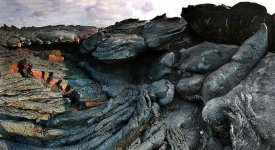
This volcano in Hawaii has been active for 700,000 years or more. Thankfully many of the eruptions are slow, but occasionally the lava flows from the volcano are fast and pose a risk to nearby towns and villages. There is also a continuing potential for dangerous earthquakes.
9. Taal Volcano, Philippines
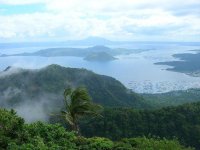
This volcano is located on the island of Luzon in the center of Lake Taal. Its proximity to Manila makes it an ongoing threat to over 1.6 million inhabitants. Since 1572, the volcano has erupted 33 times. It is recommended that visitors view Taal from a distance, though many tourists visit the volcanic island each year.
8. Ulawun, Papua New Guinea
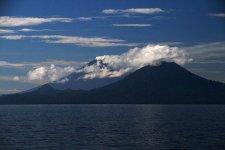
This is one of the most active volcanoes in the world. There have been 22 major eruptions recorded since the 1700s, and nearby residents report that they regularly observe minor eruptions on an ongoing basis. The structural integrity of Ulawun is questionable; if a major collapse occurs, the resulting eruption could herald destruction across hundreds of square kilometers.
7. Mt. Nyiragongo, Democratic Republic of Congo
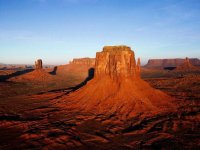
This dramatic volcano features impressive lakes of lava near its crater. These lakes come and go—sometimes quite destructively. In 1977, a particularly large lake spilled when the lake wall fractured. Lava flows traveling at 60 mph destroyed nearby villages, killing and injuring thousands. 147 people died in an eruption as recent as 2002, and another 120,000 lost their homes.
6. Mt. Merapi, Indonesia
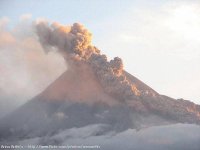
The name of this mountain means “Mountain of Fire." It is Indonesia’s most active volcano, and it has produced a record amount of lava flow. Measured in terms of flow alone, it is the most active volcano in the world. It has been active at least 10,000 years. A 2010 eruption killed 353 people and left 320,000 more without homes.
5. Galeras, Columbia
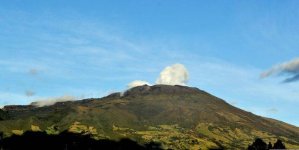
This volcano near the border of Ecuador erupts frequently and has been active an impressively long time. Scientists estimate the volcano has been erupting for one million years or more. The first recorded eruption was in 1580. Between 1978 and 1988, Galeras went temporarily dormant. Since becoming active again, it has behaved ominously, erupting almost every year since the turn of the millennium. The city of Pasto on its eastern slope is home to 450,000 residents.
4. Sakurajima, Japan
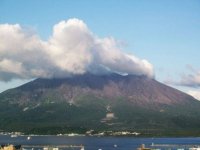
On the list of active volcanoes, Sakurajima is known as the “Vesuvius of the East," a reference to its high level of activity. It used to be separate from the mainland of Japan, but the lava flows from a 1914 eruption actually created a bridge of land connecting it to the rest of Japan. Sakurajima produces thousands of small eruptions each year. If a major eruption occurs, 700,000 residents in the city of Kagoshima will be in immediate danger.
3. Popocatepetl, Mexico
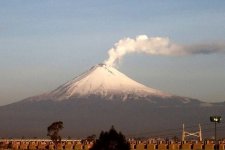
This volcano is just 35 miles away from Mexico City and erupted most recently in 2000. Forty-one thousand people would have been in danger of losing their lives if they had not been evacuated in time. Nine million people live within the blast radius. If there is ever a major eruption, it will be a mass catastrophe. This certainly makes Popocatepetl one of the most dangerous volcanoes on the planet as well as one of the most active.
2. Mt. Vesuvius, Italy
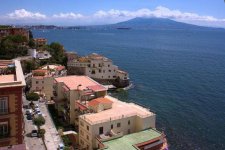
One of the most famous volcanoes on the planet is Mt. Vesuvius. Anyone who has attended a high-school history class knows about the famous, catastrophic eruption in 79 AD which destroyed the cities of Pompeii and Herculaneum. The volcanic ash preserved the two sites, making them some of the best known archaeological digs on earth. Vesuvius has an eruption cycle of roughly every 20 years. The last eruption was in 1944, so the mountain is overdue for its next eruption. Three million people are located not only within the blast radius, but close to the crater. This is another volcano which poses a serious risk to an incredible number of people.
1. Yellowstone National Park, USA
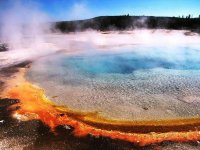
The number one volcano on our list of active volcanoes is the Yellowstone Caldera. The national park’s active volcanic caldera attracts something on the order of three million visitors per year. Its hot springs and geysers are beautiful to behold, but they are also potentially deadly. Yellowstone is a supervolcano. In fact, the last known major eruption of a supervolcano happened in Yellowstone 640,000 years ago. If Yellowstone were to blow, it is estimated that 87,000 people would be killed instantly. The entire western USA would be devastated, and the ash would also impact ecology and human health throughout the country and the world. The explosion would be a worldwide catastrophe of unparalleled proportions, and there is no way to predict how far its ramifications would extend.
We may no longer attribute the explosions of volcanoes to the whims of angry gods, but we hold the same respect for them as our ancestors did—or at least we need to, if we want to keep people safe who live within their blast radiuses. The magnitude of damage volcanoes can cause is tremendous, but they are also an important mark of our living geology. The better geologists come to understand volcanoes, the better equipped we will be to predict their explosions and protect major population centers, even while appreciating their dangerous majesty.
conservationinstitute
Volcanic activity is a regular and harsh reminder that the planet we live on features an ever-changing geology. Located along the edges of tectonic plates, volcanoes are fissures that allow the boiling magma, ash, and gases from beneath the earth’s surface to explode violently in response to shifts in the tectonic plates.
10. Mauna Loa, Hawaii

This volcano in Hawaii has been active for 700,000 years or more. Thankfully many of the eruptions are slow, but occasionally the lava flows from the volcano are fast and pose a risk to nearby towns and villages. There is also a continuing potential for dangerous earthquakes.
9. Taal Volcano, Philippines

This volcano is located on the island of Luzon in the center of Lake Taal. Its proximity to Manila makes it an ongoing threat to over 1.6 million inhabitants. Since 1572, the volcano has erupted 33 times. It is recommended that visitors view Taal from a distance, though many tourists visit the volcanic island each year.
8. Ulawun, Papua New Guinea

This is one of the most active volcanoes in the world. There have been 22 major eruptions recorded since the 1700s, and nearby residents report that they regularly observe minor eruptions on an ongoing basis. The structural integrity of Ulawun is questionable; if a major collapse occurs, the resulting eruption could herald destruction across hundreds of square kilometers.
7. Mt. Nyiragongo, Democratic Republic of Congo

This dramatic volcano features impressive lakes of lava near its crater. These lakes come and go—sometimes quite destructively. In 1977, a particularly large lake spilled when the lake wall fractured. Lava flows traveling at 60 mph destroyed nearby villages, killing and injuring thousands. 147 people died in an eruption as recent as 2002, and another 120,000 lost their homes.
6. Mt. Merapi, Indonesia

The name of this mountain means “Mountain of Fire." It is Indonesia’s most active volcano, and it has produced a record amount of lava flow. Measured in terms of flow alone, it is the most active volcano in the world. It has been active at least 10,000 years. A 2010 eruption killed 353 people and left 320,000 more without homes.
5. Galeras, Columbia

This volcano near the border of Ecuador erupts frequently and has been active an impressively long time. Scientists estimate the volcano has been erupting for one million years or more. The first recorded eruption was in 1580. Between 1978 and 1988, Galeras went temporarily dormant. Since becoming active again, it has behaved ominously, erupting almost every year since the turn of the millennium. The city of Pasto on its eastern slope is home to 450,000 residents.
4. Sakurajima, Japan

On the list of active volcanoes, Sakurajima is known as the “Vesuvius of the East," a reference to its high level of activity. It used to be separate from the mainland of Japan, but the lava flows from a 1914 eruption actually created a bridge of land connecting it to the rest of Japan. Sakurajima produces thousands of small eruptions each year. If a major eruption occurs, 700,000 residents in the city of Kagoshima will be in immediate danger.
3. Popocatepetl, Mexico

This volcano is just 35 miles away from Mexico City and erupted most recently in 2000. Forty-one thousand people would have been in danger of losing their lives if they had not been evacuated in time. Nine million people live within the blast radius. If there is ever a major eruption, it will be a mass catastrophe. This certainly makes Popocatepetl one of the most dangerous volcanoes on the planet as well as one of the most active.
2. Mt. Vesuvius, Italy

One of the most famous volcanoes on the planet is Mt. Vesuvius. Anyone who has attended a high-school history class knows about the famous, catastrophic eruption in 79 AD which destroyed the cities of Pompeii and Herculaneum. The volcanic ash preserved the two sites, making them some of the best known archaeological digs on earth. Vesuvius has an eruption cycle of roughly every 20 years. The last eruption was in 1944, so the mountain is overdue for its next eruption. Three million people are located not only within the blast radius, but close to the crater. This is another volcano which poses a serious risk to an incredible number of people.
1. Yellowstone National Park, USA

The number one volcano on our list of active volcanoes is the Yellowstone Caldera. The national park’s active volcanic caldera attracts something on the order of three million visitors per year. Its hot springs and geysers are beautiful to behold, but they are also potentially deadly. Yellowstone is a supervolcano. In fact, the last known major eruption of a supervolcano happened in Yellowstone 640,000 years ago. If Yellowstone were to blow, it is estimated that 87,000 people would be killed instantly. The entire western USA would be devastated, and the ash would also impact ecology and human health throughout the country and the world. The explosion would be a worldwide catastrophe of unparalleled proportions, and there is no way to predict how far its ramifications would extend.
We may no longer attribute the explosions of volcanoes to the whims of angry gods, but we hold the same respect for them as our ancestors did—or at least we need to, if we want to keep people safe who live within their blast radiuses. The magnitude of damage volcanoes can cause is tremendous, but they are also an important mark of our living geology. The better geologists come to understand volcanoes, the better equipped we will be to predict their explosions and protect major population centers, even while appreciating their dangerous majesty.
conservationinstitute
Attachments
-
You do not have permission to view the full content of this post. Log in or register now.
Last edited by a moderator: